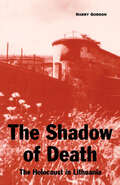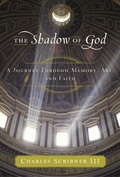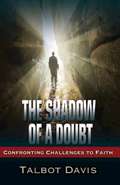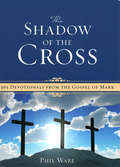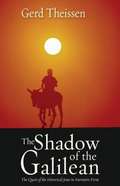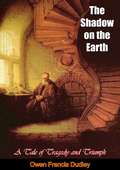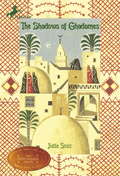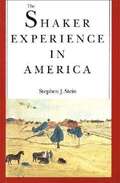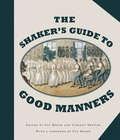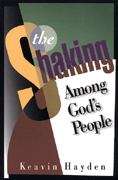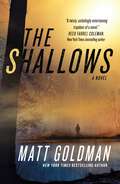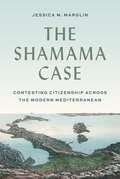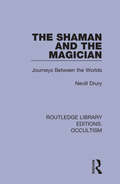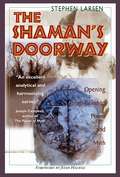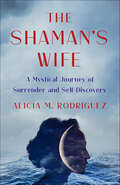- Table View
- List View
The Shadow of Death: The Holocaust in Lithuania
by Harry Gordon“A shocking story of the fate of Jews in the infamous Slobodka ghetto and the horrors of Auschwitz and Dachau.” —B’nai B’rith MessengerHolocaust survivor Harry Gordon recalls in brutal detail the anguished years of his youth, a youth spent struggling to survive in a Lithuanian concentration camp. A memoir about hope and resilience, The Shadow of Death describes the invasion of Kovno by the Red Army and the impact of Soviet occupation from the perspective of the ghetto’s weakest and poorest class. It also serves as a reminder that the Germans were not alone responsible for the persecution and extermination of Jews.“In a Holocaust memoir made unique by its rare depiction of Nazi-occupied Lithuania and by its condemnation of the local Jewish council, Gordon bears witness to the brutality of Lithuanians and conqueror alike as he reconstructs his corner of hell . . . the book makes a tremendous impact.” —Publishers Weekly“A powerful tribute to the human spirit and the will and determination of one human being to survive in a hell not of one’s own making.” —CCAR Journal: The Reform Jewish Quarterly“Preserves the record for the many in detailing major events; the ambivalent behavior of Lithuanians toward Jews; and the community organization, work, and routine of ghetto life.” —Library Journal“A timely reminder of a historic tragedy that the newly created nation would seemingly like to forget.” —The Jewish Post & Opinion“A gripping account of the horrors of the Holocaust from the perspective of the ghettos’ poorest and weakest class.” —Appalachian Quarterly
The Shadow of God: A Journey Through Memory, Art, and Faith
by Charles ScribnerThe Shadow of God is part memoir, part spiritual autobiography, and part tour of great works of art, literature, and music. In the form of a journal written over the course of a year, Charles Scribner shares childhood recollections of a household where figures like Ernest Hemingway and F. Scott Fitzgerald were family friends. He tells stories from his own noteworthy publishing career, from his journey toward faith, and from his deep knowledge of Baroque art. Born an Episcopalian, he charts the story of his interior life and the importance of the arts in helping him choose the spiritual, emotional, and intellectual paths he would follow, including his Catholic conversion. He asks himself questions like "How far back can we trace the roots of faith?" Scribner writes with contagious enthusiasm about the pivotal truths he discovered in the novels of Graham Greene and Evelyn Waugh and the inspiration he found in art, music, opera, and the Bible. The Shadow of God is a journey through memory, art, and faith that shaped Scribner's year as it passed through the seasons, from Epiphany to Epiphany. It is a moving portrait of a man who has devoted his life to words and the Word and a work of rare power by a writer whose grace, humor, and candor will touch readers.
The Shadow of God: Kant, Hegel, and the Passage from Heaven to History
by Michael RosenA bold and beautifully written exploration of the “afterlife” of God, showing how apparently secular habits of mind in fact retain the structure of religious thought.Once in the West, our lives were bounded by religion. Then we were guided out of the darkness of faith, we are often told, by the cold light of science and reason. To be modern was to reject the religious for the secular and rational. In a bold retelling of philosophical history, Michael Rosen explains the limits of this story, showing that many modern and apparently secular ways of seeing the world were in fact profoundly shaped by religion.The key thinkers, Rosen argues, were the German Idealists, as they sought to reconcile reason and religion. It was central to Kant’s philosophy that, if God is both just and assigns us to heaven or hell for eternity, we must know what is required of us and be able to choose freely. In trying to live moral lives, Kant argued, we are engaged in a collective enterprise as members of a “Church invisible” working together to achieve justice in history. As later Idealists moved away from Kant’s ideas about personal immortality, this idea of “historical immortality” took center stage. Through social projects that outlive us we maintain a kind of presence after death. Conceptions of historical immortality moved not just into the universalistic ideologies of liberalism and revolutionary socialism but into nationalist and racist doctrines that opposed them. But how, after global wars and genocide, can we retain faith in any conception of shared moral progress and, if not, what is to become of the idea of historical immortality? That is our present predicament.A seamless blend of philosophy and intellectual history, The Shadow of God is a profound exploration of secular modernity’s theistic inheritance.
The Shadow of His Hand: When Life Disappoints, You Can Rest in God's Comfort and Grace
by Judith CouchmanIdentifies God's closeness despite the disappointments and challenges of life, in a volume that recounts the author's own experiences with unfulfilled dreams.
The Shadow of a Doubt: Confronting Challenges to Faith
by Talbot DavisWe all have doubts. Throughout this five-week study, Davis invites you to acknowledge and confront your doubts about your Christian faith. Each chapter focuses on a different biblical story that illustrates a key insight into doubt and its effects on our faith. By bringing our doubts out of the shadows and into the light, we have an opportunity to experience an authentic faith seeking understanding. Discussion questions at the end of each chapter are designed to help leaders of small groups. Also available when purchasing the book is access to a free video trailer and an audio recording of the author's sermons as another way to experience the weekly message.
The Shadow of the Almighty: Father, Son, and Spirit in Biblical Perspective
by Ben Witherington III Laura M. IceThe Shadow of the Almighty introduces readers to the nature of God by exploring the biblical references to God as "Father," "Son," and "Holy Spirit." This fruitful approach offers fresh insight into the meaning of the biblical language used for God, giving readers the background necessary for properly understanding the trinitarian perspective of the New Testament and of the Christian faith. Divided into four chapters, the book looks at "Father" language in early Judaism, at "Father" language in early Christianity, at "Son" language, and at language designating the Spirit. This thorough review of the traditional God language across the biblical texts shows what the earliest Christians understood by using these terms and, ultimately, what these terms mean for modern faith and practice. While much of this material is deceptively familiar, the authors' close examination of how and where the different terms are used reveals some surprising results. It makes clear, for example, that speaking of God in trinitarian terms was not as radical a departure from early Jewish monotheism as many have thought, and it shows that while early Christianity was characterized by disparate ideas, the first Christians nevertheless shared a common understanding of God. Equally engaging findings of the book include the authors' support for the traditional gendered term "Father" when speaking about God. Complete with helpful questions at the end of each chapter, The Shadow of the Almighty provides an excellent place to begin a deeper study of God.
The Shadow of the Cross: 365 Devotionals from the Gospel of Mark
by Phil WareThe Shadow of the Cross is a one-year devotional guide to the Gospel of Mark using one short passage each day and following the Gospel from beginning to end. Each passage is followed by a Key Thought and a Prayer. The Key Thought opens up the day's Scripture and shows how it challenges us to live for Jesus.
The Shadow of the Galilean: The Quest of the Historical Jesus in Narrative Form,Updated Edition
by Gerd TheissenFirst published in 1987 by Fortress Press, this 20th anniversary edition of this classic bestseller includes a new Afterword from the author. Here, in narrative form, is an account of the activity of Jesus of Nazareth, scrupulously constructed so that it does not undercut the insights of New Testament scholarship. What makes it different from other such attempts is that Jesus never actually appears. What we find everywhere is his shadow, his effect. Such an approach avoids the usual pitfalls of the genre and lends this story - attributed to a fictitious narrator - an attraction, freshness, and power all its own. Tension and interest are maintained to the end, even for those sated with books about Jesus. Careful documentation in the footnotes shows how much of the narrative is based on ancient sources.
The Shadow on the Earth: A Tale of Tragedy and Triumph
by Owen DudleyShadow of the Earth is the second of Father Dudley’s books on the problems of human happiness.It is a novel which endeavors to furnish an answer to the problems of Evil.A young man is injured in the mountains and is taken to a monastery where he is cared for by Brother Anselm, one of the monks. In the shock of discovery that he is crippled for life, he denounces God and turns against the friendly monk. An atheist and a Christian Scientist offer the consolation of their beliefs, but he finds at last in Catholicism, as taught and practiced by Brother Anselm, the faith he needs to face life.“A book full of strength and beauty.”—The Signet“A beautiful piece of work; it shows its author as both philosopher and true artist in words.”—Catholic World
The Shadowed Mind (Dinah Harris Mysteries #2)
by Julie CaveA suspense-filled mystery which answers an ominous question: Who will be found worthy to live; who is the next victim? After the deadly investigation into the Smithsonian murders, Dinah Harris is now facing a daily battle to keep her sobriety while struggling to form a new career from the ashes of her former job as an FBI agent. From the shadows will emerge a cunning and terrifying killer, who carefully and methodically will decide whose life has value to society and whose does not. Using her profiling and security skills as a private consultant based in Washington, DC, Dinah uncovers a connection to the shadowy world of neo-eugenics, and those who publicly denounce the killings but privately support a much different view. Against this backdrop, Dinah must come to terms with her own past, as those associated with the deepening mystery face their own personal demons, and struggle with the concept of God's inexhaustible grace and forgiveness. Old secrets are revealed, tragedies unearthed, and the devastating legacy of science without compassion is finally brought to light. The second in a powerful new fiction trilogy! juliecave.com
The Shadows of Ghadames
by Joelle StolzIN THE LIBYAN CITY of Ghadames, Malika watches her merchant father depart on one of his caravan expeditions. She too yearns to travel to distant cities, and longs to learn to read like her younger brother. But nearly 12 years old, and soon to be of marriagable age, Malika knows that--like all Muslim women--she must be content with a more secluded, more limited life. Then one night a stranger enters her home . . . someone who disrupts the traditional order of things--and who affects Malika in unexpected ways."I was enchanted by this story of a brave Berber girl who dares to dream and its filigree of details about harem life, ancient trade routes, goddesses and healers. The real beauty of The Shadows of Ghadames is that it transcends the exotic to explore universal truths about the condition of being human."--Suzanne Fisher Staples, author of Newbery Honor Book,Shabanu: Daughter of the WindFrom the Hardcover edition.
The Shadows of Poetry: Vergil in the Mind of Augustine (Transformation of the Classical Heritage #26)
by Sabine MacCormackImperial ceremony was a vital form of self-expression for late antique society. Sabine MacCormack examines the ceremonies of imperial arrivals, funerals, and coronations from the late third to the late sixth centuries A.D., as manifest in the official literature and art of the time. Her study offers us new insights into the exercise of power and into the social, political, and cultural significance of religious change during the Christianization of the Roman world.
The Shah of Iran, the Iraqi Kurds, and the Lebanese Shia (Middle East Today)
by Arash ReisinezhadThis book sheds new light on the emergence and fluctuation of Iran’s connections with non-state entities in the Middle East. Iran’s involvement with political-militant non-states has been at the heart of international and regional security policy for more than three decades. The author analyzes Iran’s non-state foreign policy by focusing on specific geopolitical and geocultural threats and opportunities that pushed Tehran to build strategic ties with the Iraqi Kurds and the Lebanese Shia. This project will appeal to multiple audiences interested in geopolitics of the Middle East, Iran's foreign policy, and international relations.
The Shaken Path: A Christian Priest's Exploration of Modern Pagan Belief and Practice
by Paul CudbyDespite modern Paganism being one of the fastest growing new religious movements in Britain and the USA, there is no up-to-date straightforward and informed introduction to modern Paganism from a Christian perspective. The Shaken Path addresses that gap.
The Shaker Experience in America: A History of the United Society of Believers
by Stephen J. SteinThe Shakers, once a radical religious sect despised and harassed by their fellow Americans, have in more recent times become celebrated for their communal way of life, their pacifism and equality, and not least for their handicrafts. This book is a history of the Shaker belief.
The Shaker's Guide to Good Manners
by Flo Morse Vincent NewtonThe intimate guide to life as a Shaker in 19th century America "Never make more free with your inferiors than you are willing they should make with you; it learns them to be saucy." Such sage words of advice come from Mother Ann Lee's Society of the Shakers, who in 1844 published A Juvenile Guide, or Manual of Good Manners, Consisting of Counsels, Instructions, & Rules of Deportment for the Young. Known for their piety, their economy, and (perhaps most famously) their celibacy, the Shakers knew a thing or two about etiquette and proper decorum. With this incredible artifact of a bygone era, you can experience what it was like to live in a rural 19th century religious community, where children were taught to "be careful not to talk too loud, nor too much" and to "always have a place for every thing, and keep every thing in its place."
The Shakers
by Lesley HerzbergLeaving Manchester, England, in 1774 to avoid religious persecution, the Shakers crossed the Atlantic and during the next 50 years established 19 villages in the United States from Maine to Kentucky. Guided by the principles of utility, honesty, and order, the ultimate goal of the Shakers was to create a heaven on earth in both their worship and their work. Consequently, careful craftsmanship, signature details, an dthe commitment to excellence are seen in every object they produced, ranging from free-standing tables, chairs, desks, boxes, and case clocks to built-in cupboards and cases of drawers. The unique buildings, objects, and lifestyle of the Shakers has set them apart in American art and culture as a matter of course, but ever since "Shaker Handicraft" - the first major Shaker exhibition at the Whitney Museum of American Art in 1935 --the appreciation for Americana and folk art has continued to grow. Today the spirit of Shaker craft, combined with its clean lines, solid construction, and honest functionality, make it one of the most popular and timeless design categories in the US and beyond.From the Trade Paperback edition.
The Shaking Among God's People
by Keavin HaydenA lay evangelist, Keavin Hayden is familiar with various divisional segments within Adventism and how they relate to the church. He is a strong advocate of unity between church leadership and laity for the completion of the preaching of the three angels' messages... [Hayden says] Ellen White told us that "the shaking must soon take place to purify the church" (Spiritual Gifts, vol. 2, p. 284). What did she mean by this statement? There seems to be confusion among Adventists regarding this issue. In this timely book Keavin Hayden examines what God has revealed to us about the shaking, answering such questions as: * When will the shaking take place? * Has it already started? * What is God's purpose in it? * Will a remnant come out of the organized church, or will God sanctify a remnant within it and by their faithful testimony purge the church from evil? * What tactics will Satan use to sift people out of the church?" * In what specific ways will the faithful be tested? * How can thorough reformation take place in our church? * How can we have assurance of victory?" Even if you are not a Seventh-Day Adventist, you will gain much by reading this book since Hayden discusses principles that apply to all Christian and Messianic-Jewish believers.
The Shallows: A Nils Shapiro Novel (Nils Shapiro #3)
by Matt GoldmanIn the words of Lee Child on Gone to Dust, “I want more of Nils Shapiro.” New York Times Best Selling author and Emmy Award-winning writer Matt Goldman obliges by bringing the Minneapolis private detective back for another thrilling, stand-alone adventure in The Shallows.A prominent lawyer is found dead, tied to his own dock by a fishing stringer through his jaw, and everyone wants private detective Nils Shapiro to protect them from suspicion: The unfaithful widow. Her artist boyfriend. The lawyer’s firm. A polarizing congressional candidate. A rudderless suburban police department. Even the FBI.Nils and his investigative partners illuminate a sticky web of secrets and deceit that draws national attention. But finding the web doesn’t prevent Nils from getting caught in it. Just when his safety is most in peril, his personal life takes an unexpected twist, facing its own snarl of surprise and deception.In The Shallows, Goldman delves into the threat of dark history repeating itself while delivering another page-turner with his signature pace, humor, and richly drawn characters.At the Publisher's request, this title is being sold without Digital Rights Management Software (DRM) applied.
The Shamama Case: Contesting Citizenship across the Modern Mediterranean
by Jessica MarglinHow a nineteenth-century lawsuit over the estate of a wealthy Tunisian Jew shines new light on the history of belongingIn the winter of 1873, Nissim Shamama, a wealthy Jew from Tunisia, died suddenly in his palazzo in Livorno, Italy. His passing initiated a fierce lawsuit over his large estate. Before Shamama's riches could be disbursed among his aspiring heirs, Italian courts had to decide which law to apply to his estate—a matter that depended on his nationality. Was he an Italian citizen? A subject of the Bey of Tunis? Had he become stateless? Or was his Jewishness also his nationality? Tracing a decade-long legal battle involving Jews, Muslims, and Christians from both sides of the Mediterranean, The Shamama Case offers a riveting history of citizenship across regional, cultural, and political borders.On its face, the crux of the lawsuit seemed simple: To which state did Shamama belong when he died? But the case produced hundreds of pages in legal briefs and thousands of dollars in lawyers&’ fees before the man's estate could be distributed among his quarrelsome heirs. Jessica Marglin follows the unfolding of events, from Shamama's rise to power in Tunis and his self-imposed exile in France, to his untimely death in Livorno and the clashing visions of nationality advanced during the lawsuit. Marglin brings to life a Dickensian array of individuals involved in the case: family members who hoped to inherit the estate; Tunisian government officials; an Algerian Jewish fixer; rabbis in Palestine, Tunisia, and Livorno; and some of Italy&’s most famous legal minds.Drawing from a wealth of correspondence, legal briefs, rabbinic opinions, and court rulings, The Shamama Case reimagines how we think about Jews, the Mediterranean, and belonging in the nineteenth century.
The Shaman & Ayahuasca: Journeys To Sacred Realms
by Geraldine Overton-Wiese Don Jose CamposMore and more Ayahuasca has come to the attention of the Western media.<P><P> Used by the shamans of Peru , the rituals and practices around this psychoactive plant-based brew date back 50-70,000 years as evidenced by rock and cave paintings found the world over. Through their use of Ayahuasca, Shamans establish contact with the spirit world which they call upon to aid them in their healing practices, understanding of the cosmos, and how to live well in the world.In The Shaman & Ayahuasca, internationally respected Peruvian shaman Don Jose´ Campos illuminates the practices and benefits of Ayahuasca with grace and gentleness, while expressing respect and gratitude for the gifts Ayahuasca has bestowed on him throughout the 25 years he has been a practicing shaman. He takes the reader on a journey through his own discovery of other worlds, other dimensions, 'alien' entities and 'plant teachers.' The Shaman & Ayahuasca gives an overview of an entire cosmology with the potential to benefit all of mankind. It is the perfect book to introduce readers to the profound experiences of Ayahuasca.
The Shaman and the Magician: Journeys Between the Worlds (Routledge Library Editions: Occultism #1)
by Nevill DruryOriginally published in 1982, The Shaman and the Magician draws on the author’s wide experience of occultism, western magic and anthropological knowledge of shamanism, to explore the interesting parallels between traditional shamanism and the more visionary aspects of magic in modern western society. In both cases, as the author shows, the magician encounters profound god-energies of the spirit, and it is up to the individual to interpret these experiences in psychological or mythological terms. The book demonstrates that both shamanism and magic offer techniques of approaching the visionary sources of our culture.
The Shaman and the Medicine Wheel (Quest Bks.)
by Evelyn Eaton"The more we meditate on the Medicine Wheel and on the Cosmic Wheel above, relating these to the circles, spheres, and mandalas of other traditions, the deeper our realization grows of the oneness of the many paths leading to the Center." Although Evelyn Eaton walked principally the Native Indian path, this book reflects her belief in the strength and beauty of all religious traditions. This is the personal account of her triumph over cancer through Native American healing rituals. Of white and Native American ancestry, Eaton was a Metis Medicine Woman.
The Shaman's Doorway: Opening Imagination to Power and Myth
by Stephen LarsenThe Shaman’s Doorway is one of the most significant and inspiring works on the relationship of shamanism to both the psyche and society. Drawing on his experience as a psychotherapist and his understanding of primordial shamanic traditions, Stephen Larsen shows the relevance of this path to the modern world and how it can lead to a creative and affirmative relationship with life. “Life dismembers us,” Larsen says, and a new grasp of these ancient techniques for altering consciousness is required to escape from the alienation and confusion caused by our demythologized and industrialized environment. Defining the task of the shaman as one of bringing meaning and healing into life, Larsen clearly shows how the shaman, all too often perceived as belonging to the world’s past, holds the key to our future.
The Shaman's Wife: A Mystical Journey of Surrender and Self-Discovery
by Alicia M. RodriguezEmpowering and told from a unique perspective, this globe-spanning memoir of self-discovery and sacrifice has a singular, resounding message for its audience: love is boundless, but it must begin with nurturing oneself.When Alicia Rodriguez, a successful entrepreneur recovering from divorce and loss, accepts an invitation to Ecuador to help a friend who is studying with a shaman, she has no idea how profoundly the decision will change her life’s course. In Ecuador Alicia meets Napo, a powerful shaman, and they begin an extraordinary relationship that spans two continents and eight years. As their connection deepens, Alicia learns the principles of shamanism and witnesses Napo’s remarkable healing abilities. Confronted with the illusion of her life in the United States, she decides to move to Ecuador to be with him, and they make plans to build a healing center together on the coast. Within a short time, however, she realizes that she has surrendered her power and agency to Napo, who now wields it as a weapon against her. After years of inner struggle, Alicia finally finds the courage to leave Ecuador and moves to Portugal, where she finds peace . . . until an unexpected phone call rekindles old memories. An extraordinary memoir steeped in spirituality, shamanism, and metaphysics, The Shaman’s Wife is the story of a woman who, through a daring journey of self-discovery, reclaims and embraces her feminine wisdom—and realizes that love is the answer to her lifelong spiritual quest.
